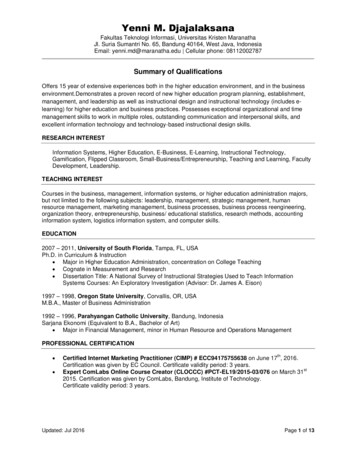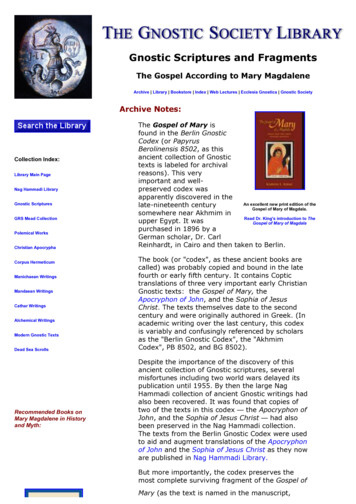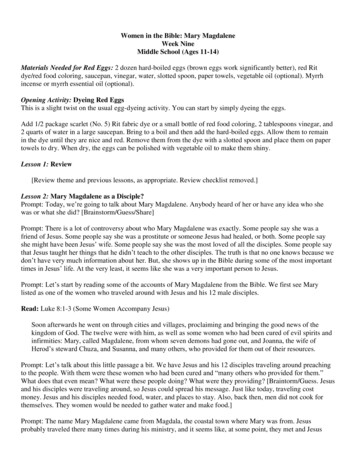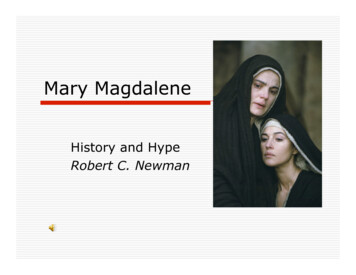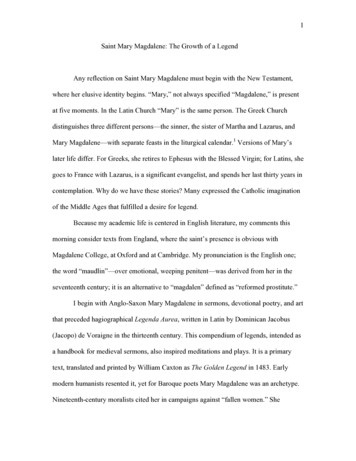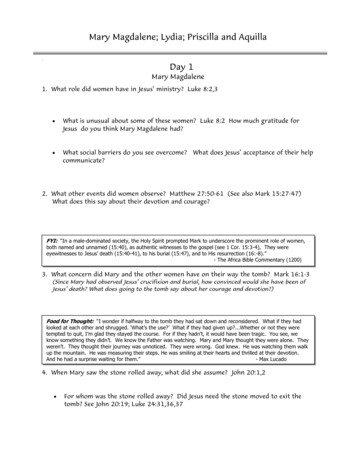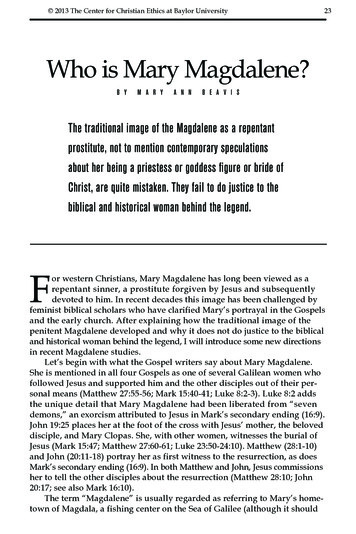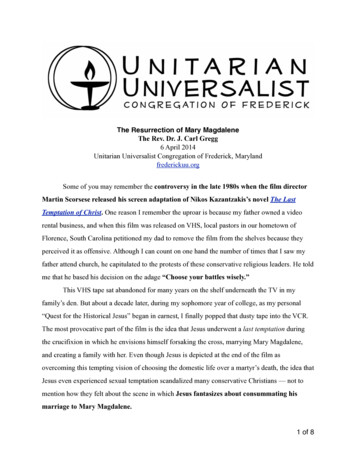
Transcription
oMaryMagdaleneThe woman the worldcan never forgetRobert J. WielandRobert J. WielandThe Woman the World Can Never Forget1
This story in the Gospel of Mark is so striking that it charmseveryone willing to listen. Like a precious jewel displayed inan ugly pot, it is set between two of the worst stories everwritten - the one about the Jewish leaders' crucifixion ofChrist, and the one about Judas Iscariot’s betrayal of Him.In the middle is this woman so badly twisted out of shape bysexual exploitation that the Bible says "seven devils" hadgotten control of her. The four Gospels furnish a surprisinglycomplex knowledge of who she was and why she did heroutlandish deed. Yet Jesus has enjoined upon us the dutyof telling this story of Mary Magdalene"WHERESOEVER THIS GOSPEL SHALL BE PREACHEDTHROUGHOUT THE WHOLE WORLD."This book has to be a partialfulfillment of His command!Printed in Australia byMaranatha MediaEmail: adrian@maranathamedia.comWebsite: maranathamedia.comLayout and DesignTalking Rock Sabbath ChapelEmail: info@talkingrocksabbathchapel.comWebsite: www.talkingrocksabbathchapel.com2Talking Rock Sabbath Chapel Publishing
Who was Mary Magdalene?This story in the Gospel of Mark is so striking that it charms everyonewilling to listen. Like a precious jewel displayed in an ugly pot, it is setbetween two of the worst stories ever written – the one about the Jewishleaders’ crucifixion of Christ and the one about Judas Iscariot’s betrayal ofHim.In the middle is this woman so badly twisted out of shape by sexualexploitation that the Bible says “seven devils” had gotten control of her.The four Gospels furnish a surprisingly complex knowledge of who she wasand why she did her outlandish deed.Yet Jesus has enjoined upon us the duty of telling this story of MaryMagdalene “wheresoever this gospel shall be preached throughout thewhole world ” (Mark 14:9, KJV). This book has to be a partial fulfillmentof His command!The Woman the World Can Never Forget3
ContentsWho was Mary Magdalene? . 1Foreword . 6Why Do We Write about Mary Magdalene?. 8Chapter 1: Meet an Unusual Lady . 10John supplies another important detail that Mark omits . 12Who was this lady? . 12How could she ever have gotten this way? . 13Chapter 2: How Mary Met Jesus . 15A lesson from Jesus’ prayers . 17Now at last she was free! . 18Chapter 3: How Can Mary Say “Thank You”? . 19Simon comes into the spotlight . 20But how could he?. 21What could Jesus do for him? . 23But what happened to Mary? . 24Chapter 4: “What is Faith?” Jesus Answers. 25The link between the love of Christ and the faith of Mary . 26Did she help Jesus? . 27A debt to Christ and a debt to this woman!. 27But why did Jesus praise her so extravagantly? . 28But Jesus Himself defends Mary . 29Pathetically, we see ourselves in the cold-hearted Simon and the Twelve. 304Talking Rock Sabbath Chapel Publishing
Chapter 5: How Mary’s Deed Illustrates Christ’s Sacrifice for Us . 31Consider the sacrifice of Mary’s deed . 31The magnificence of Mary’s deed shines brightest when likened to thatof Jesus’ sacrifice . 32Beware of misunderstanding . 34Chapter 6: The “Works” That Mary’s Faith Did . 35We owe the full five hundred silver coins . 36Chapter 7: Mary Magdalene and Those Strange “144,000” . 37The “144,000” have a special role in this last great drama . 40Mary, your brothers and sisters are coming!. 41Jesus rejoiced before He drew His last breath . 42The Woman the World Can Never Forget5
ForewordThis strange lady holds a legendary place in the Bible story. With thepossible exception of the mother of Jesus, more has been written abouther than about any other lady.Mary Magdalene captures the imagination of almost everybody who hearsabout her mysterious and exotic act of anointing Jesus’ feet with “preciousointment,” and then washing them with her tears – the only one such actever recorded in human history.Perhaps the most monumental work in print about Mary is Susan Haskins’Mary Magdalene: Myth and Metaphor (Harcourt and Brace, 1993). It’s awhopping 518 scholarly pages, heavily endnoted and indexed. It exploresthe non-canonical “gospels” and the writings of Church Fathers andscholars all through the centuries and religious art. Its basic message: themystery only deepens the further one digs in non-biblical literature andart.Our modest essay is concerned only with what comes to light in the fourGospels – Matthew, Mark, Luke, and John. But when context is consultedin each, a surprisingly detailed portrait of this lady emerges.There has to be a reason why Jesus bespoke for her act the specialattention of everybody in the world wherever “this gospel” is to beproclaimed. Let’s explore the story:“In only two days the eight-day Festival of Passover and theFeast of Unleavened Bread would begin. The high priests andreligion scholars were looking for a way they could seize Jesus bystealth and kill Him. They agreed that it should not be doneduring Passover Week. ‘We don’t want the crowds up in arms,’they said.“Jesus was at Bethany, a guest of Simon the Leper. While He waseating dinner, a woman came up carrying a bottle of veryexpensive perfume. Opening the bottle, she poured it on Hishead. Some of the guests became furious among themselves.“‘That’s criminal! A sheer waste. This perfume could have beensold for well over a year’s wages and handed out to the poor.’6Talking Rock Sabbath Chapel Publishing
They swelled up in anger, nearly bursting with indignation overher.“But Jesus said, ‘Let her alone. Why are you giving her a hardtime? She has just done something wonderfully significant forMe. You will have the poor with you every day for the rest ofyour lives. Whenever you feel like it, you can do something forthem. Not so with Me. She did what she could when she could –she pre-anointed My body for burial. And you can be sure thatwherever in the whole world the Message is preached, what shejust did is going to be talked about admiringly.’“Judas Iscariot, one of the Twelve, went to the cabal of highpriests, determined to betray Him. They couldn’t believe theirears, and promised to pay him well. He started looking for justthe right moment to hand Him over” (Mark 14:1-11, TheMessage).The Woman the World Can Never Forget7
Why Do We Write about Mary Magdalene?Why should Jesus say that the story of one bad sinner must be toldeverywhere?1. As a photographic print resembles its negative, so her strange actresembled His great sacrifice. Jesus had to defend her, for in doingso He was defending Himself, His cross.2. She had paid an enormous price for that alabaster flask ofprecious ointment (300 silver coins, the wage of a working man fora year). Jesus paid an enormous price to redeem us.3. What Mary did was wildly extravagant – “wasting” an entire flaskof “very precious” ointment when only a teaspoonful was needed;so what Jesus did was equally (more so!) extravagant – sheddingHis blood sufficient to save an entire world when only a handful ofpeople will respond.4. Mary’s motive was totally non-selfish; she had no thought of beingpraised. All she wanted to do was say, “Thank you, Lord, for savingmy soul!” So Jesus’ motive was purely and simply love for lostpeople, no acquisitive purpose mixed in to becloud that pureflame of devotion for us. Mary was unconsciously reflecting themotives of Jesus. Her perceptions, her discernment, were moresensitive than that of any of the twelve disciples.5. The Bible singles her out as a “sinner,” meaning an outstandingone (see Luke 7:37); she was “forgiven much,” not little. She knewit, realized it; therefore, her now-converted sinful heart could bestretched outsize to “love much” (Luke 7:47). Hence, her amazingdeed was the most beautiful ever performed by any repentantsinner in history.6. Jesus, therefore, saw in her an example, a “prototype,” ademonstration, of what His agape-love could and wouldeventually produce in “144,000” people.7. Her act of love in no way contributed to her salvation; it was onlyan expression of gratitude for her salvation already accomplished.Thus Jesus defined the clearest demonstration of what the word faithmeans: “Go in peace,” He said. “Your faith has saved you” (Luke 7:50, KJV).Jesus nailed down, for all time to come, a clear definition of faith: a heart8Talking Rock Sabbath Chapel Publishing
appreciation of what He has done for us in saving us from hell itself. Whenfaith is so understood, it can do nothing else than “work” (see Galatians5:6).The Woman the World Can Never Forget9
Chapter 1: Meet an Unusual LadyWhat can “the truth of the gospel” do for one whose life has become atragic ruin?Here’s a basket-case woman badly twisted out of shape by sexualexploitation. Its ruinous after-effects were so bad that the Bible says“seven devils” had control of her (Mark 5:2,8,9,15; 16:9). Let’s review thestory in our familiar, more literal version:“And being in Bethany at the house of Simon the leper, as He satat the table, a woman came having an alabaster flask of verycostly oil of spikenard. And she broke the flask, and poured it onHis head.“But there were some who were indignant among themselves,and said, ‘Why was this fragrant oil wasted? For it might havebeen sold for more than three hundred denarii1 and given to thepoor.’ And they criticized her sharply.“But Jesus said, ‘Let her alone. Why do you trouble her? She hasdone a good work for Me. For you have the poor with youalways, and whenever you wish you may do them good; but Meyou do not have always.’“‘She has done what she could. She has come beforehand toanoint My body for burial. Assuredly, I say to you, wherever thisgospel is preached throughout the whole world, what thiswoman did will also be spoken as a memorial to her’” (Mark14:3-9, NKJV).Mark doesn’t identify this woman, but he uses a literary device that pointsus to the lady who is called Mary Magdalene in Mark 15:40, 47, and Mark16:1, 9. Matthew tells the story much like Mark does, but likewise he doesnot identify the heroine (Matthew 26:6-13). But John identifies her clearly(John 12:2-9).1A denarius was a Greek coin equivalent in value to a workingman’s wage for aday (Matthew 20:2). Three hundred would be about a year’s wages.10Talking Rock Sabbath Chapel Publishing
She is either a brilliant person who is right on, or she turns out to be a wildfanatic. Those “three hundred denarii” (silver coins) are a fantastic sumwhich she blew in just a few moments of aromatic bliss at this party. Atfirst thought, it would seem that the “some” who didn’t like what she didwere thinking clearly. Jerusalem and its suburbs were full of poor peoplewho could have used the food or clothing that this princely sum couldhave purchased for them.But Jesus saves her from a fanatic’s ignominy. He transforms her into afamous lady: never did He speak so highly of any other contemporaryperson! How could you ask for a higher endorsement under Heaven? Thismodest book has come into existence as a tiny fruition of that encomiumby Jesus – her story must be proclaimed “throughout the whole world.” Infact, the sobering truth dawns on us that maybe we can’t reallyunderstand “this gospel” unless we hear and appreciate what the Biblesays about this lady!There’s something in the story that strikes long dormant chords of music inour souls. We may preach all about the many “doctrines” that we havebeen pleased to speak of as “the present truth,” but if we omit this story,we have deprived our listeners of essential truth that people in these lastdays are hungering to understand.Jesus intended that her story be a part of the proclamation of “theeverlasting gospel” for the world. Not until our “time of the end” has iteven been possible that it could be told “throughout the whole world,” asHe said. Heart-warming truth in this story will yet penetrate the age-oldbarriers of soul set up in the hearts of Hindus, Muslims, Buddhists, pagans,hard-hearted secularists, lukewarm Christians, all men. We may discoverthe reason why our message hasn’t yet gripped the consciousness of the“worldly” world we have yet to reach.Convincing the intellect with PowerPoint doctrines is great; but unlessthe heart has been reached, our efforts are in vain. Isaiah speaks of howthe Father hid His Son Jesus as a secret weapon, a “polished” arrow in “Hisquiver,” to penetrate to the world’s heart. In Mary’s quiver is theevangelism arrow that will make its way into now hard-to-reach heartsaround the world.The Woman the World Can Never Forget11
What Jesus said seems clear: we must employ her to help us reach theheart. But unless our own heart has been melted, how can we do it?John supplies another important detail that Mark omitsHe spills the beans on the surprising identity of who those “some” werewho condemned Mary’s prodigal offering of “very precious” ointment(John 12:1-8).To the eternal embarrassment, the critics turn out to be the twelveapostles! Only a few days before Calvary, here they are with no betterunderstanding than to join in condemning what turns out to be the mostbeautiful deed ever performed by a repentant sinner, something thatilluminates what happened on the cross.Then the apostle John reveals an even more embarrassing detail. Besidesconfirming that the otherwise unnamed heroine was Mary Magdalene, hetells us why the Eleven apostles were so ready to lend their voices to thebitter denunciation of her: they were blindly following the lead of JudasIscariot, the soon-to-be-traitor and betrayer.The Eleven didn’t come up with those cruel words of condemning Mary’soffering. But they were willing to be led by the most notorious apostate ofall time, and this within a week of the crucifixion, which they should havebeen preparing for. They had all the instruction Jesus had been givingthem. (But they hadn’t been listening.)Of course, Christ forgave them for following Judas into this disgracefulmisjudgment, but for all eternity they will humble their forgiven souls fortheir blind willingness to follow the traitor in condemning the sacrifice ofChrist. (Condemning Mary’s deed involves condemning Jesus, as we shallsee.)Who was this lady?It has been popular through the ages for scholars and theologians to labelMary Magdalene a prostitute. A surprisingly detailed mosaic pictureemerges from a study of all that the four Gospel writers say about her, butseems no suggestion there that she was a prostitute. Instead, her problemwas some kind of sin that landed her in demon possession.12Talking Rock Sabbath Chapel Publishing
Bible narratives are unabashed in portraying individuals as prostitutes ifthat’s what they were. Nothing is hidden. Mary may seem to have had aneven more serious problem than simple prostitution: some scholarsbelieve they see evidence that she was a nymphomaniac, a woman drivenout of her reasoning mind by a demon of lust that was apart from a desirefor monetary gain.Sexual demon possession is not a pleasant obsession. Its captives are heldfast because the entanglement of sex in our psychic makeup goes down tothe primeval roots of our existence. We are beings created in the image ofGod, “male and female.” Sex is not something for jokes; it’s a life or deathinvolvement in the profound creative mysteries of God.And it was not one demon in Mary that called for exorcism; seven swirledabout in her soul. The numeral “seven” is not a mere euphemism. Biblicalevidence suggests that she was a very intelligent person; and the moreintelligent you are, the more demons can inhabit your soul once they getin. This woman was far, far gone.How could she ever have gotten this way?God does not create people in such a condition! The mosaic prose piecesin the four Gospels fit together to indicate that the person who initiallyabused her sexually was Simon the Pharisee (the story as Luke tells it inchapter 7 can mean nothing else, as we shall see2). Jerry L. Walls andJoseph R. Dongell analyze a hypothetical example of what happens to aninnocent girl who suffers this fate. This is an insightful glimpse into whatcould well have been the source of Mary Magdalene’s problem: “Considerthe case of a young girl who is sexually abused by her uncle. Theexperience is emotionally devastating and contributes significantly to adeep negative self-image, which, among other things, leads her into sexualpromiscuity. She continues to struggle with feelings of guilt andinferiority throughout her life.”3Mary’s sexual abuse had obviously been foisted on her when she wasyoung and vulnerable. Although her older sister and brother are23I am indebted for this detail to Ellen G. White, Signs of the Times, May 9, 1900.Why I Am Not a Calvinist, InterVarsity Press, 2004, p. 208.The Woman the World Can Never Forget13
prominent in the Bible story, there are no details of a father, who wouldhave been Simon’s brother. For some reason, he seems to have droppedout of sight. Contextual flashes in the story suggest that Mary’s upbringingand education were supplied by Simon, the prominent church leader wholived in Bethany (a suburb of Jerusalem near the home of Mary’s sisterMartha and brother Lazarus).As sometimes happens with uncles and nieces, Simon could have initiatedan emotional relationship with Mary. Fatherless, she could haveinnocently responded to his subtle aggression. Carsten Johnson in his littlevolume, The Writing in the Sand, the Part of the Story That You WereNever Told About Mary Magdalene,4 suggests that she became pregnant.If so, Uncle Simon would have desperately wanted to exile her as soon aspossible, lest his holy and reverend reputation be sullied by gossip thatwas unmistakably real. Mary’s journey away would have been embitteredby the deepest resentments any young woman can know.The popular view that identifies her with the woman taken in adultery inJohn 8:1-11 seems to lack a Biblical hint of support. Mary’s problem wasdemon possession, not adultery. As a Jewish young woman of an excellentfamily receiving devout early training with siblings Martha and Lazarus,she would unlikely have gone into either prostitution or adultery. Even so,the context can’t fit. The woman of John 8 was in Jerusalem, and Mary’sproblems occurred in Magdala, far north in Galilee.Very likely, when we consider human nature, it seems reasonable thatMary would go to Magdala just to bury herself in shame. She took anosedive into the darkness of despair. The “nuthin’ goin’ nowhere”philosophy could well have been hers. Dark as hell despair withcorresponding unbelief became the setting for multiple devil possession.Further, the timing of the story of the adulterous woman of John 8 is setnear the end of Christ’s ministry, close to its denouement whencontention with the nation’s leaders foretold His coming crucifixion. ButMary’s problem became evident long before, during Christ’s FirstMissionary Journey, because her deliverance occurred either then orshortly after. We find she accompanied the group on their Second4New York: Vantage Press, 1984.14Talking Rock Sabbath Chapel Publishing
Missionary Journey. Mary’s identity hardly fits either a Jerusalemprostitute or adulteress.Uncle Simon was a very prominent, well-respected religious leader. Theremust be no story of any improper relationship with Mary leaked to themedia of the day. Always taught to respect the elders and patriarchalheads of the family, Mary subjected herself to be meek and to be troddenunderfoot, her self-respect gone, and her emotional foundationsshattered. As frustration and hopelessness settled in on her soul, sheharbored so much bitter hatred in her heart that she became distraughtemotionally. When her intellectual acumen was joined with emotionaldespair, there was a recipe for a brilliant kind of devil possession. “Seven”would describe it well.If she had been totally bereft of self-respect (a heart condition such devilpossession would produce), other men as well could have abused her(Roman soldiers were in Galilee). Her hatred toward men in general onlywould go deeper and become more bitter. Thus it wouldn’t be long beforeshe became a human soul inhabited by these agents of ancient darkness.When the Bible insists on “seven,” it implies that she was beyond anyone’stherapeutic help.But it became her good fortune to meet Someone who knew how to help,Someone who can help us, too.Chapter 2: How Mary Met JesusPerhaps brother Lazarus or sister Martha had arranged the contact. Neverhad she met a man remotely like Him. Artists and novelists through theages have run wild imagining a sexual attraction between Mary and Jesus,but the Bible doesn’t hint of such.Jesus knew Himself to be the Son of God, but He was also the Son of man,totally human, “in all points tempted like as we are, yet without sin”(Hebrews 4:15). His humanity was constantly on display. But there hasnever been a woman on Planet Earth so beautiful and charming that shecould aspire to become the bride of the incarnate Son of God. He wasalready “in love,” “engaged” if you please, with what the Bible speaks of asThe Woman the World Can Never Forget15
some other “woman,” His pure church-to-be. His nuptial love was alreadydirected there. The church, in a corporate sense, will eventually be “theLamb’s wife” for whom He has had to wait long until she will “makeherself ready.”Meanwhile, in His incarnation, no woman could take her place. No lesserlove could have appealed to Jesus! Those who write these novels andmovies don’t understand the character of Jesus or the nature of true love.When you’re already in love, no other can intrude (which is why adulteryis impossible for anyone who is in love!). The Son of God has always lovedHis spouse-to-be.In His incarnation, Jesus had too much true love in His heart, known asagape, ever to have given any woman the slightest encouragement tothink of Him romantically-tempted, although the Bible says He may havebeen. It was terrible enough for Him to let His innocent mother watch Himbe crucified; how could He have let any other woman be so tortured, evenif we allow Him all the humanity which He possessed?Scripture singles out Mary His mother as the only woman of history whosesoul had to be “pierced through by a sword” as old Simeon told her in thetemple (Luke 2:34, 35; the Greek says it was to be romphaia, the greatsword of Goliath). Jesus would spare any other woman from sharing Hisown mother’s soul torture!But Jesus loved Mary Magdalene, that’s for sure, the same as He loved anyother human soul. It was with an unselfish, pure, self-sacrificing love.Having been “made in the likeness of men” (Philippians 2:7) and as alone“He knew what was in man” (John 2:25), He understood Mary as no otherhuman being ever had. He understood the labyrinthine complexities of herfemale human nature, in particular the abused nature of her soul. Himselfman’s Creator and Redeemer, He knew as no other man how she felttoward men.In even such a casual contact, Jesus would convey in some way to eachhuman soul He met a sense of self-sacrificing agape love. If that soulwould open the heart to “behold” it, a certain measure of reciprocitywould immediately be initiated. The recognition would at first be beyondwords, for “deep calleth unto deep” when one’s “soul is cast down,” as16Talking Rock Sabbath Chapel Publishing
was hers.5 It was not an instinctive response on her part, but one fardeeper than that, for Jesus said, “My sheep hear My voice and theyfollow Me” (John 10:27). Mary heard the Voice, however faint its echomay have been in her darkened and deafened soul. We read that “agapenever faileth” (see 1 Cor. 13:8). Evidently, even in demon possessed soulsthat are honest, the capacity to sense agape also “never faileth.”In the hidden stratum of her consciousness, Mary began to sense thedivine implications of an unearthly love that drove Him at last to His cross.That was what won her soul. There was recognition there, on her part, ifonly a millivolt in strength. It had seemed to her an utter impossibility thatthere could be any man on earth who could love with purity, that is,genuinely. But this One did. The last spark of soul that lingered alive in herheart was awakened. She wanted what He had, something infinitelybeyond sex or human companionship.A lesson from Jesus’ prayersIf ever you are tempted to wonder why you must pray and pray again,and then pray again, for someone’s conversion (or even for your own!),take heart from this story of Mary Magdalene. Even Jesus, the divine Sonof God, “the Savior of the world,” had to pray “seven times” before Marywas delivered. Her case was a difficult one (and so is every lost soul’s,including yours and mine).Nothing in the Bible story suggests that this prayer season was on oneoccasion only. A wise writer tells us that “seven times she had heard Hisrebuke of the demons that controlled her heart and mind.”6 Demons don’tgive up easily, especially sexual ones. Whatever the nature of her lust,Mary found only temporary relief with the expulsion of the first demon;but her confidence was initiated. She began to see some hope. Littleflowers as at springtime after a hard winter began to blossom in her mindand heart. Yes, she could become a woman of self-respect again!But then when temptation assailed her, she fell. And nothing hurts sobadly as to fall after you think you have been delivered. In her renewed56Psalm 42:7.Ellen G. White, The Desire of Ages, p. 568.The Woman the World Can Never Forget17
despair, Mary could have offered the Psalmist’s prayer, “Thou hast liftedme up and cast me down” (Psalm 102:10). But Jesus prayed for her again,and again she was delivered. A second demon cast out!It’s hard to imagine (unless you have yourself been through battles withaddiction) that this went on seven times! You can just hear Judas Iscariotand the disciples telling Jesus that this woman is hopelessly gone. “Youcan’t save everybody; she’s had it! You’re making a fool of Yourself to prayfor her again!” But a seventh time He prayed for this lost soul.We are not wise enough to know who that seventh devil was that wasfinally cast out. But from limited pastoral experience, one would suggestthat very likely it was the bitter resentment that Mary had harbored allthese years against the man who had ruined her life, against the one whohad trampled on her soul and selfishly climbed up his career over thewreckage of her life.But when she could bring herself to forgive him, to repent in a corporatesense in his behalf, to realize that as a member of the human race she toohad “sinned and come short of the glory of God,” (Rom. 3:23) and whenshe could sense that she had no right-eousness of her own but it was all100% imputed from Christ, then a new light began to dawn on her.Nothing would have been possible unless she could have come to sensethat his sin would have been her sin but for the grace of a Savior. Then shediscovered how the impossible task before her had become possible: sheforgave him.Now at last she was free!The seventh and last devil was gone. Now she was singing, “[My] soul isescaped as a bird out of the snare of the fowlers; the snare is broken, and[I am] escaped” (Psalm 124:7). There was no thought of performing an actof penance. That little millivolt of sensing agape had developed into alightning surge of heart appreciation for it. She had escaped from hellitself! Like Christian and Hopeful escaping from Giant Despair’s darkdungeon when they looked with tears on the bodies of others just asworthy who had perished there in unbelief, she knew only tears of humblebut grateful contrition.18Talking Rock Sabbath Chapel Publishing
Her conversion was not a program of works. All she did was to appreciatewhat she saw in Jesus. Her faith was proven to be genuine because itimmediately went to work, as we shall see.Chapter 3: How Can Mary Say “Thank You”?She had already been to hell and come back. The bitterness she had drunkwas terrible.The Bible does not tell us of any other person who has suffered thetorments of seven demons or felt so “forsaken” of God (the GrandException, of course, being the Savior on His cross who cried out, “MyGod, why have You forsaken Me?”).In her lost condition, as far as humanly possible, Mary had plumbed thedepths of the horror that will eventually face those who choose to sufferthe second death with Satan.7 To walk out of that dark cave into thesunlight of God’s love filled her soul with a happiness no one can describe.(We could all share that joy if only we could appreciate the darkness of thecave where we would be – but for the grace of Christ!)
of telling this story of Mary Magdalene "WHERESOEVER THIS GOSPEL SHALL BE PREACHED THROUGHOUT THE WHOLE WORLD." This book has to be a partial fulfillment of His command! Printed in Australia by Maranatha Media Email: adrian@maranathamedia.com Website: maranathamedia.com Layout and Design Talking Rock Sabbath Chapel
